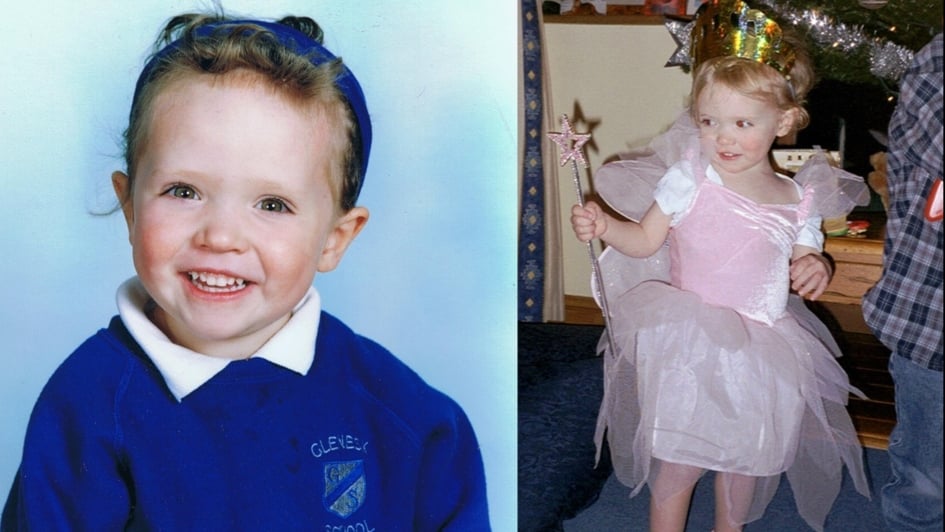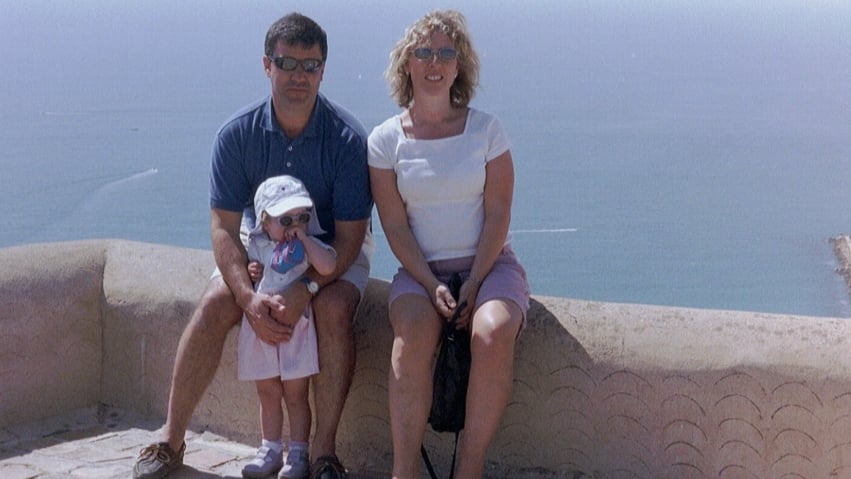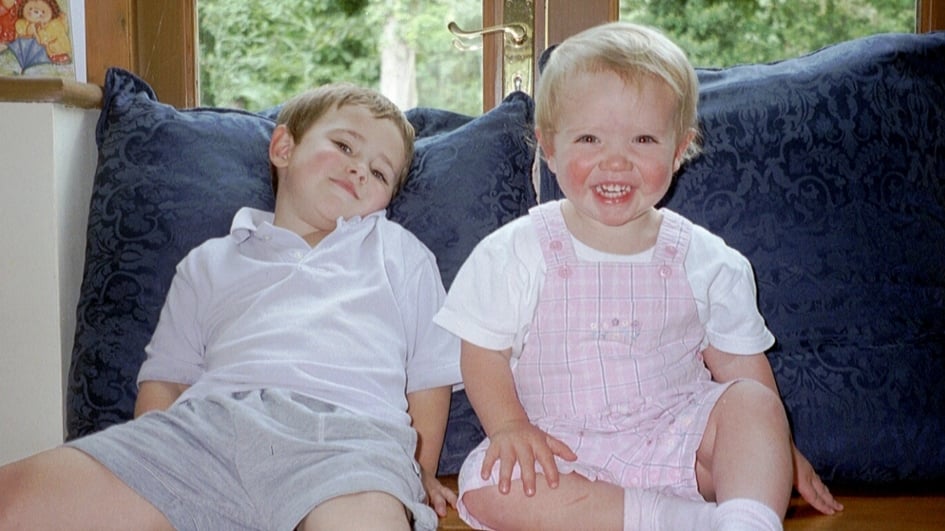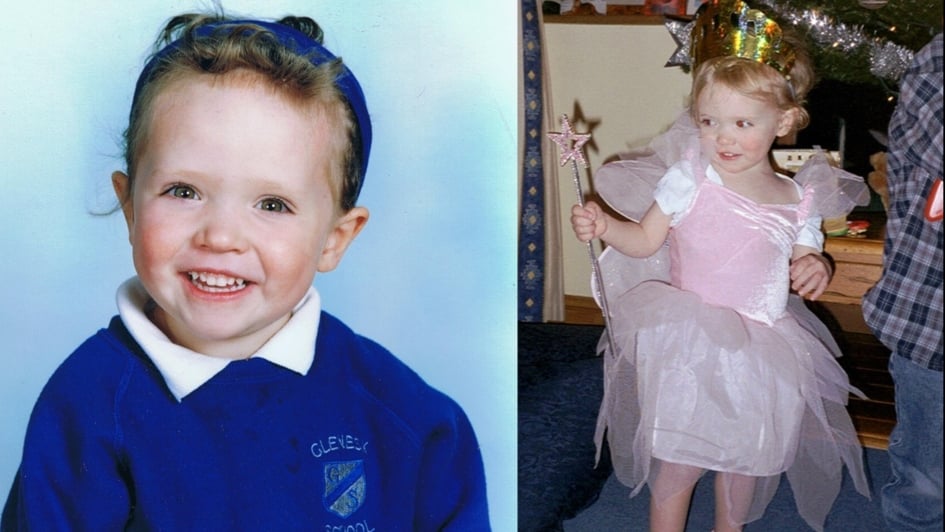
Image: Abbie in school uniform (left), and Abbie dressed as a fairy (right). Credit: Mike Shaw/Abbie's Fund.
I remember when Abbie was given a toy vet centre for Christmas. It became a particular favourite of hers, and she had a great time playing with it. She used to love taking care of her teddies and toys and giving them x-rays. It mirrored real life in a sad sort of way, but Abbie didn’t see it like that.
Every parent would say their child is special and unique, but Abbie really was amazing at getting the most out of life. She squeezed absolutely every opportunity out of every minute she had, and she made everyone happy to be around her.
When Abbie first started being ill, it was nothing significant. She was a bit under the weather at times and had a sort of ‘simmering temperature’, as we called it. We’d give her a dose of Calpol – I remember we used to take a bottle out with us wherever we went – and she’d be straight back to normal.
When we took her to the local clinic though, they noticed that she’d lost a bit of weight. Alarm bells started ringing, and Abbie was referred to the local GP. Eventually we saw a paediatrician who, within a few seconds, spotted there was a significant lump – a tumour – in Abbie’s stomach.
Abbie was put straight into the care of The Royal Marsden, and had a range of scans and tests. It sounded like the tumour was a Wilms’ tumour, a rare kidney cancer that mostly affects young children.
This was in December 2002, when Abbie was just 19 months old. Later that month, Abbie was sent to St George’s hospital for a biopsy. During the procedure, they found she was bleeding into the tumour, so they removed it then and there, along with her left kidney and adrenal gland. And then, after spending several days in intensive care, Abbie was released. On Christmas Eve, she was given her first dose of chemotherapy drugs.
‘I knew nothing about neuroblastoma’
We got the results of the biopsy back within a matter of weeks. It was worse than we were expecting. Abbie didn’t have a Wilms’ tumour. She had adrenal neuroblastoma.
My wife, Liz, and I knew nothing about neuroblastoma. I don’t think most people have heard of it. At the time, we certainly hadn’t.

Image: Mike, Liz and Abbie on holiday. Credit: Mike Shaw/Abbie's Fund.
We had no idea what this mystery disease was that our daughter had, and we spent hours researching it. The more we looked, the more we realised what a horrendous cancer this was.
A cancer diagnosis immediately makes you think death, and it’s almost impossible not to focus on outcomes and statistics. And mostly you come across the bad stories as they go on for years, and not the good stories because those children get better and so then there isn’t much else to talk about.
So the more we looked, the more bad news we found. In the end, we stopped looking.
But we were hopeful. The tumour had been removed, and we hoped it might have been removed early enough for everything to be okay. And Abbie had been diagnosed with stage 1 cancer, which, in a weird sort of way, we were delighted about, because stage 1 is the ‘best’ you can get.
The next few months were great. Abbie started nursey, and had a birthday party, and she went on playdates with friends. It was normal life for a two-year-old: simple and fun. And it was so nice that way. And Abbie was being regularly monitored, so we had a team watching over her.
Then, in June 2003, they noticed Abbie’s blood pressure had gone up. She had various tests which seemed to indicate that the cancer was back, and so she was booked in for an MIBG scan – a special scan which can detect the presence of neuroblastoma. This involved Abbie lying still under a large scanner plate for almost an hour, which would have been difficult for anyone, let alone a two-year-old. But she was an absolute star and, thanks to some help from Postman Pat, she did it.
The scan showed the cancer had spread. It was in her bones and bone marrow. Her cancer was now stage 4.
There were still positives to cling on to. Our consultant had treated much worse cases than Abbie’s, and the children had been okay. Abbie was fit and healthy (which, to be honest, made the whole thing even more unbelievable). And our consultant told us that treatment of high-risk neuroblastomas had progressed a lot.
It was the worst news imaginable, but there was hope.
Abbie was amazing
When you get a stage 4 diagnosis, you go onto a standard treatment protocol. Over the next 12 months, Abbie had chemotherapy, surgery, more chemotherapy (high-dose this time), a stem cell transplant, and radiotherapy. Throw into the mix various other treatments, like antibiotics for a low white blood cell count, injections to aid blood clotting and medicine for low potassium levels.
The medicine for her potassium levels was truly foul-tasting. Why isn’t children’s medicine made to taste like chocolate?
We ended up trying to disguise it in her food. Pills were crushed into pasta sauce and Nutella, and liquid medicines were mixed with strong Ribena. The trouble is that so many of the medicines were so horrid, and had to be given in such large doses, that she could still detect them. So then we were left wondering how much of the dose she had actually had.

Image: Abbie Shaw holding a teddy bear. Credit: Mike Shaw/Abbie's Fund.
It was an intense year, but Abbie was amazing. Bizarrely, she loved The Royal Marsden. We never understood why. Nothing against the place, but we’d say ‘Abbie, we’re going for a sleepover at the Marsden’, and she’d say ‘yaaay’.
At that age, children don’t really understand what’s going on. Abbie used to understand that she’d got a lump in her tummy that shouldn’t be there, and that the treatment she was having was to get rid of the lump, but not much more than that. It was sometimes quite difficult to explain, because Abbie often felt perfectly well. She didn’t think anything was wrong, yet she was doing regular trips to the hospital.
But she was brilliant about it. She never used to complain. She never used to get upset. She just took it as normal life.
Sadly, for Abbie, I guess it was.
As a parent, it’s a very strange thing to go through. You hear about childhood cancer, and you read about it, but you can’t imagine it will happen to you. When it was happening, there wasn’t really time to analyse what was going on. We were swept away on this rollercoaster, and we just had to ride it. And because Abbie dealt with it so well, it helped us deal with it.
Abbie’s brother, Jamie, was two years older than her. He understood a little bit more about what was going on, but he was still too young to really know what was happening. He was brilliant. He and Abbie played so well together. It didn’t matter if Abbie was in a bed in hospital, or running around the house with a plaster on her leg and tubes up her nose, she was still a real rough and tumble expert. A rough and tumble expert who loved annoying her brother.
Our daughter
After all that intense treatment, life returned to an element of normality, and it was great. Abbie’s hair began growing back, her fitness and appetite were returning, she had a party and celebrated her birthday with friends. She started swimming, dancing, and gymnastics. She began learning to read, and she taught herself to write her name.

Image: Jamie and Abbie sat on the sofa. Credit: Mike Shaw/Abbie's Fund.
In the lead up to Christmas that year, Abbie was selected to be a cow in the school nativity play. She was disappointed she wasn’t going to be a donkey.
Abbie wasn’t a cancer patient. She was just Abbie. Our daughter. Our three-year-old.
Then, in March 2005, when Abbie was four, she developed a limp. She’d been to a party at a soft play area, so the obvious answer was that she’d bounced badly and got injured. But as time went on, we knew something wasn’t right.
We took her for scans and tests and, in the process, discovered the cancer was back. It was in the bones and the bone marrow. Abbie had relapsed.
It's one thing to hear your child's got cancer. To hear they've relapsed is just horrendous.
Although I don't think it was ever said, we knew that relapse was pretty much terminal.
So, Abbie was back in hospital again. We told her the lump in her tummy had come back. Luckily, she'd been off treatment long enough that there were options available. She had more chemotherapy and then a radioactive treatment.
After these, the disease completely disappeared. The scans were amazing – nothing could be seen.
But you only need one or two cells lurking, and the cancer evolves and comes back again. And, sadly, that's what happened. And it kept coming back.
It got to the point where we started having end-of-life conversations. Everything was about keeping Abbie comfortable and happy.
And mostly she was happy. We made so many great memories in that time.
Through the Make-A-Wish Foundation, Abbie got to be a princess for a day. She was taken to the Disney Store in Guildford in a pink stretch limo, and she and Jamie were given free rein and allowed to choose anything they wanted. And then the limo took her to a grand hotel where she was treated like royalty, and a butler served her a princess menu.
We went on holidays to Hastings and the New Forest, Abbie took part in school concerts, she won a race on sports days in a high-speed buggy, she danced at a disco. There is so much to look back on and cherish.
We talk about Abbie all the time at home. Her other two siblings, who weren’t born when we lost Abbie, know everything about her. They know her quirks and her funny sides. They know the same little girl Liz, Jamie and I do.
Abbie would be chuffed to bits
Abbie lives on in our memories, but she also lives on through Abbie’s Fund.
The charity Abbie’s Fund was set up after Abbie relapsed in 2005, and a group of mothers from the local community arranged an amazing event to raise money for neuroblastoma research. And then Abbie passed away, but the charity lived on.
Every year, when the September anniversary of her death passes, it gives us a chance to remember what it was like going through this journey with Abbie and to realise how everything has progressed beyond our wildest dreams.
We’ve raised over £700,000 to date. Most of this has been used to support the amazing work of Professor Louis Chesler and his team at the ICR, and we are so pleased with everything they’re achieving.
Our support has enabled them to make huge progress in developing blood-based testing for children with cancer. This technology allows clinicians to understand the genetic variants – the individual differences – in each child’s cancer, and it allows them to choose the treatment options that are most likely to work.
It also helps to discover when a child has relapsed, before symptoms start to show.
The progress that’s being made is incredible. The tagline for Abbie’s Fund is ‘make my childhood cancer survivable’, and in the space of a few years, we’ve gone from faint hope to realising it actually might be possible.
Abbie would be delighted to know that there was a charity named after her, but she’d be absolutely chuffed to bits to know that she was helping to, hopefully, lead to a cure for this horrendous cancer.
We are world-leaders in the study of cancer in children, teenagers and young adults. Our international research efforts are key in transforming how childhood cancers are treated.
Find out more about our Family Charity Partners, whose support and dedication drives our work forward.
